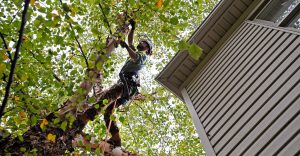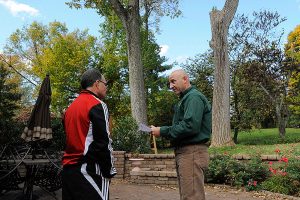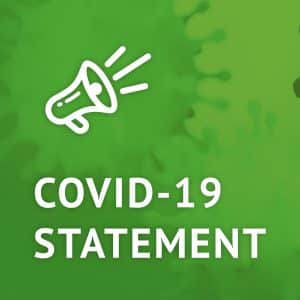First, tree identification is key. What type of tree do you have? . Keep reading and learn how to identify your trees in no time! If you still cant figure out what type of tree you have, reach out to one of our Certified Arborists!

An ash tree is identified by a few signs:
- There’s an opposite branching pattern (two branches come off the primary stem, one on each side and opposite one another.
- It has complex leaves with 5-11 leaflets (based on the specific species of ash). Leaflets are somewhat toothed and might be stalked.
- In winter: first look for the opposite branching pattern and strong twigs of ash. Little branches develop off bigger branches opposite one another. Also, buds and leaf scars are opposite one another on new twigs.
- Next, Ash trees have numerous little dots on their leaves, forming a semi-circle or crescent pattern.
- White and green ashes have thick, diamond-patterned bark, while black ash bark is thin, gray, and scaly.
- Ash species attacked by emerald ash borer consist of green, white, black and blue Ash trees. Green and white ash would be the most commonly found ash species in Kentucky with blue ash becoming rare. Note:
- While other hardwood trees like the Mountain Ash and Prickly Ash, have the same name, they’re not true Ash Trees. Consequently they’re not vulnerable to attack by emerald ash borer.
- Ash trees are abundant in Kentucky, with estimates as high as 500 million trees in forests and more than 5 million in urban locations. Ash is an element of three common forest types in Kentucky including Elm, Ash, Cottonwood, Northern Hardwood and Oak / Hickory.
- Ash wood is used for making flooring, Louisville Slugger baseball bats, tool handles, cabinets and far more than most people realize.
Winter is a good time for you to begin your tree identification education.
The forest is open, you’ll find no bugs, and as opposed to a cloud of vegetation, many trees stand out solidly and possess a distinctive winter look. Some are evergreen, some have pods, old leaves, leftover fruit, spines or giant buds – and a tree’s silhouette is much more visible without having the wrap of leaves.
Get field guides for your neighborhood trees. It really is great to possess both a basic regional guide, as well as a much more specific guide for your region. You can never have too many field guides, the more pictures you’ve got the easier it will be to recognize a certain tree. Field guides can be acquired free of charge at your neighborhood library. Used bookstores could be yet another great source.
If you are just beginning your tree identification experience, concentrate on identifying types of trees by making use of mainly pictures of bark, leaves, flowers and fruit to identify trees. Then begin studying drawings, which are a lot more complex and specific. Different guides also can offer fascinating historical details about different types of trees.
Stay away from ornamental’s, if you are inexperienced. Anything planted within a gardens, lawn, roadside, park, is usually an ornamental. Ornamental’s are different types of native species which can be totally different and can make tree identification almost impossible. There are literally thousands of ornamental trees and they can be from all over the world. In order to identify your regions basic ornamental trees, there are numerous guides for the arborist and horticulturist about planting and developing ornamental trees.
Go for any stroll, and take some guides with you. For those who have the time to sit at the base of a tree you need to learn, and study more than field guides. Tree identification requires a whole lot of patience and concentration. It may take at the very least 30 minutes of studying different guides just before you’ve found it.
Focus on types of trees trees that are prominent, as opposed to going systematically from tree to tree. Choose a tree which has at the very least one, if not two very easily identifiable characteristics – like a leaf or flower or fruit. Bark just isn’t so simple to learn, either is tree growth characteristics. Leaves will be the easiest to utilize. Begin with an evergreen. You’ll find very few native evergreen trees with brad leaves in the U.S.

Look for left over growth up inside the branches. The tulip tree for example, with its large vertical trunk and thin upright flowers, that stay all winter, is common and simple to recognize.
Learn your tree families, instead of isolating trees by specific species. A peach, a cherry, a plum, a hawthorn, a pear, are all in the identical family, with edible fruit – the rose family. Trees with pods are in the same family, like silk tree, mesquite and locust. There are not a whole lot of different tree families in any area in the world – if you can class your trees in their respective families you are going to be far better able to identify them and their characteristics. Other examples are beech and oak and chestnut are all in the edible nut family. Cottonwood is actually an enormous member of the willow family, a family that grows beside water. The tulip tree is in the magnolia family – it has huge flamboyant flowers, just like the magnolia.

What else to look for in identifying tree.
- Look for anything flowering, even inside the dead of winter. For example the red maple is usually the first tree to flower in the spring – in the South that’s actually in February.
- Look for leftover fruit, since they can occasionally remain deep in to the winter. Fruit is very easy to recognize. Great examples are cherry trees.
- Look for trees with giant buds, also old woody remnants of the earlier year’s fruit.
- Look for trees still keeping their dead leaves all through the winter. or trees like the conifer which holds onto its cones all year. Tree identification by dead leaves, needles and cones is a great way to start.
- Take photographs with your phone, and save them in a folder with the name in the caption. Begin compiling a database of trees. Tree identification will become a lot easier if you can quickly reference photos.
There are also great tree identification app’s like Leaf Snap that will actually help you with your tree identification education.
Reach out to Bob Ray Co. Your trusted tree care and tree removal company serving Kentuckiana!



